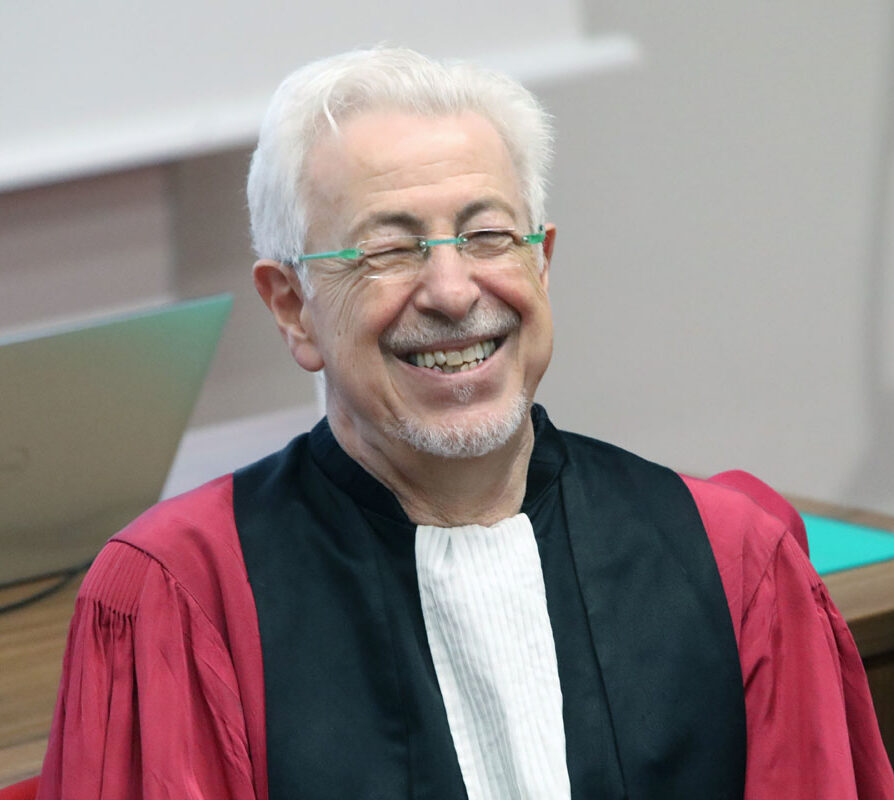Oussama Khatib: diving into robotics
With his Ocean One diving archaeology robot, the director of the Stanford Robotics Lab and world-renowned researcher Oussama Khatib is shining a spotlight on the mysteries of the deep sea and robotics. On February 20, on the recommendation of his French peers Philippe Poignet, Vincent Creuze, and Philippe Fraisse, all three of whom are robotics researchers at Lirmm, the Franco-American was awarded an honorary doctorate from the University of Montpellier.

On this Monday afternoon, more than 120 people have been invited to the amphitheater of the science village to attend a small event in the world of robotics. In a few minutes, Oussama Khatib, director of the Stanford Robotics Laboratory, will give a lecture entitled "The Age of Human-Robot Collaboration." This inaugural lecture is in keeping with the spirit of the day's highlight: the ceremony awarding an honorary doctorate from the University of Montpellier to this internationally renowned researcher.
First steps in France
"One of the fathers of modern robotics, a pioneer and visionary." With these words, Philippe Poignet, director of the Montpellier Laboratory of Computer Science, Robotics and Microelectronics (LIRMM), begins his eulogy for his American colleague. The speech, written jointly with his two colleagues Vincent Creuze and Philippe Fraisse, emphasizes how this honorary doctorate celebrates the collaboration between two teams, not to mention between two countries. Oussama Khatib is not only familiar with France, but also with Montpellier, where he first arrived in 1969 after spending his youth in Syria.
He stayed there long enough to complete a master's degree in electronics and automation before moving to Toulouse, where he wrote his thesis. At the time, he developed a new mathematical method known as "potential field" that revolutionized the way robots move. His work attracted considerable attention and earned him a post-doctoral position at the prestigious Stanford University in California, where he has remained ever since. What followed were fifty years of research and innovation, making Oussama Khatib one of the most visionary robotics researchers of his generation, as Philippe Fraisse, who collaborated with him for many years, attests: "He was the first to understand the importance of human-robot interaction and the scientific challenges that need to be overcome in order for robotics to contribute to technical and social progress in our modern societies."
Aiming for the Moon with Ocean One
But it is undoubtedly his latest creation, not to say creature, that has caused the most of a stir: the Ocean One diving robot. Let's go back in time to 2016. We are off the coast of Toulon aboard theAndré Malraux, the ship of the French Department of Underwater and Underwater Archaeological Research, Drassm. On the deck, excitement is building among the archaeologists, who are eager to see the star of this mission in action. A two-meter-long orange body weighing two hundred kilograms, eyes equipped with cameras, two seven-jointed arms extended with interchangeable hands and manipulated using haptic interfaces capable of providing the operator with tactile sensations. Ocean One is as surprising for its humanoid silhouette as it is for the sophistication of its equipment.
Surrounded by archaeologists, Oussama Khatib talks with Vincent Creuze, a researcher in underwater robotics. Together, they are finalizing the last details of this historic dive. In a few moments, Ocean One and Speedy, the LIRMM robot, will set off to explore the wreck of the Lune, a ship belonging to Louis XIV that sank in 1664 and lies 91 meters below the surface."It was a relatively shallow depth ,"explains the Montpellier-based researcher."The aim of these initial tests was to demonstrate that Ocean One was capable of recovering and handling objects underwater with the same delicacy as an archaeologist."
This initial success paved the way for several years of collaboration between the two researchers and their respective research laboratories, with a single goal in mind for the Stanford researcher: to take Ocean One to a depth of 1,000 meters, where human divers cannot go. This goal was almost achieved in February 2022 in an underwater canyon off the coast of Cannes. There, thanks to the collaboration of DRASM andArthur, Vincent Creuze's latest prototype, the American humanoid robot, dived to a depth of 852 meters. "On board the AlfredMerlin, DRASM's new boat, Ocean One is really in its element. The entire environment has been designed for him so that he can work optimally with Arthur and achieve the goals that Oussama has set," explains Vincent Creuze.
Promotion of robotics
The news quickly spread like wildfire throughout the small world of robotics and far beyond. "Oussama Khatib is an extremely generous researcher who has done a great deal and continues to do a great deal to promote robotics around the world," says Vincent Creuze. Everything he produces is immediately made available to the scientific community. " And indeed, when the Stanford researcher is not at sea, he is in the air, traveling the globe between conferences to offer advice and seminars to the many universities, foundations, and companies that are eager to hear him. In France, he has been a member of the Strategic Research Council since 2014, responsible for informing the French government's decisions on national research strategy.
A ministerial schedule that does not prevent him from devoting as much time as possible to his students, "to whom he is extremely attentive," emphasizes Vincent Creuze, but also and above all to his role as president of the prestigious International Foundation for Robotics Research (IFRR). He has drawn on this foundation to developISER, an international symposium on experimental robotics held every two years since 1989 and now established on every continent: Malta, Buenos Aires, Tokyo, Delhi, Sydney, Honolulu, Morocco, and even Toulouse in 1991.
"This symposium is truly his brainchild. It is a highly selective event, with fewer than sixty papers presented, but it also gives young researchers the opportunity to meet the world's leading robotics specialists. " This makes us even more fortunate to count among the honorary doctors of the University of Montpellier a scientist such as Oussama Khatib, who stated in March 2022 in the newspaper Le Monde: "What do I imagine? Fleets of humanoid robots working together under the supervision of one or more operators to perform tasks that are risky for humans. That is the way forward. That is the future."
